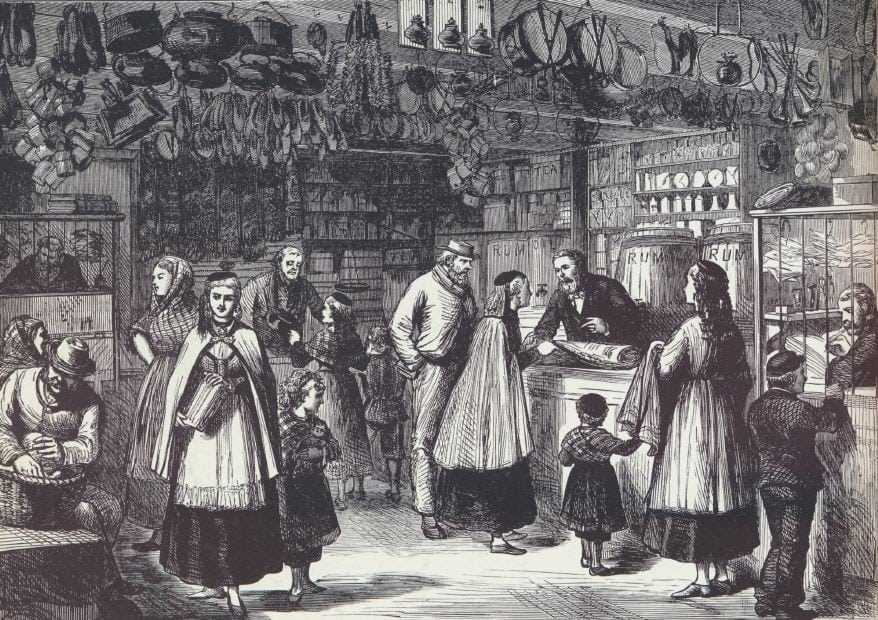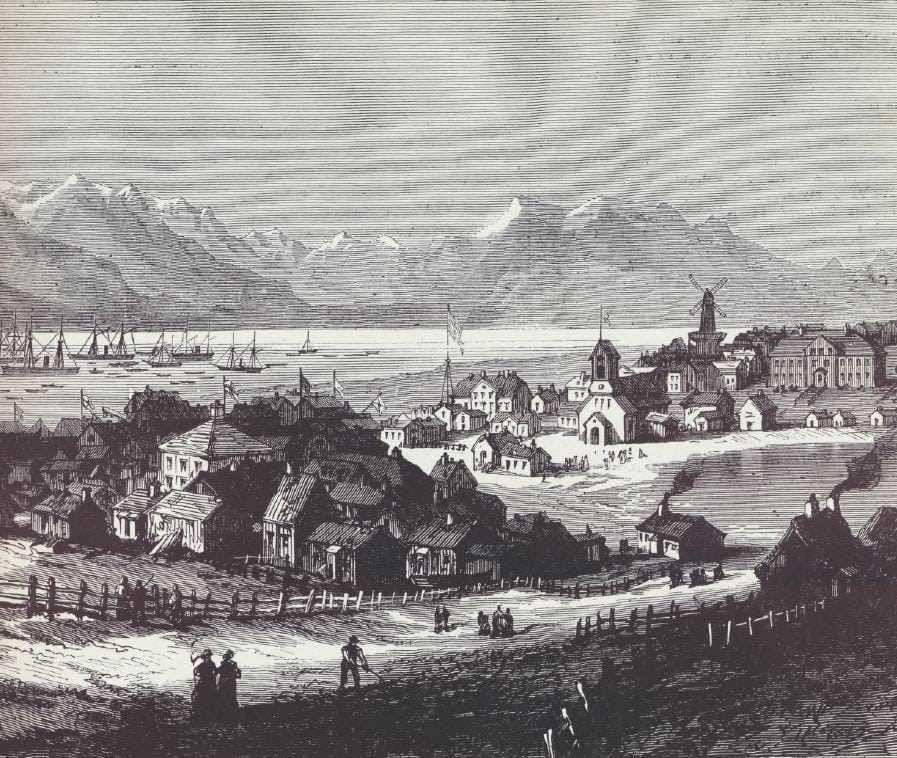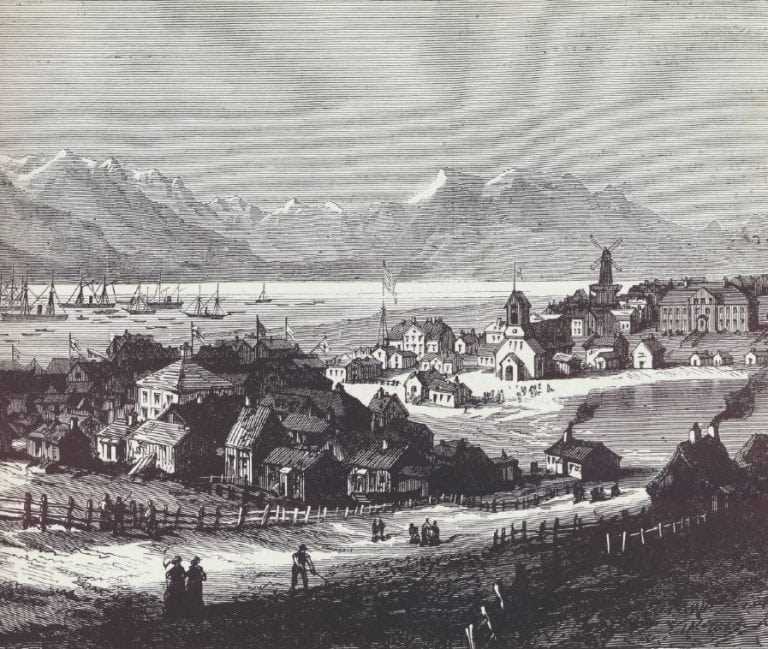Reykjavik (smokey bay) is one of the many place names in Iceland containing the element reyk from reykur (smoke). The “smoke” the first settlers saw on sighting land for the first time was undoubtedly steam rising from hot springs in Laugardalur valley. As mentioned above (pg. 18), slaves belonging to Ingólfur Arnarson, the first Norseman to settle in Iceland, found Ingólfur’s high seat pillars washed ashore at Reykjavik, and it was there he built his farm. This would have been in 873 or 877, depending on whether Ingólfur arrived in 870 or 874. The latter date has become traditional in the country’s history.
At the time of the settlement all hills in Reykjavik must have been covered with trees or bush. But the saga says that not all of Ingólfur’s household were pleased with his choice of a place to settle. In Landnámabók (Book of Settlements), it is recorded that his slave Karli said: “It was a waste of time to travel through such good country if we are to settle here on this remote peninsula.” His utterance is not surprising when one considers that they had traveled over some of the country’s most fertile land, all the way from Ingólfshöfði to Ölfusá. But Ingólfur trusted in his gods. His high seat pillars, carved with figures of the Norse deities, would guide him to his future home, he would build at the spot where they drifted ashore. It is possible that some of his followers had ridden overland west over Hellisheiði to Reykjavik, and his ships probably sailed from Ölfusárós (the mouth of the river Ölfusá) around Reykjanes to Reykjavik with baggage and household goods. It was logical to found a farmstead in Reykjavik. Among the bays, ponds, and hollows where the old city centre of Reykjavik now stands, there was a sheltered spot for the farm. There was enough wood in the forests and driftwood close at hand as well.

In 1962, important archaeological research was begun in this area, first by drilling and then by excavating, to see if relics of human habitation as far back as the age of the settlement could be found. During excavation, shavings and pieces of wood from what was clearly a human dwelling were found, and which Carbon 14 dating showed were from trees felled about 810 A.D. From 1971-73, excavations were undertaken at the corner of Aðalstræti and Túngata. Among the finds were the remains of stone walls, charcoal and stones from a hearth. There were layers of volcanic ash which fell at the time of the settlement in the turf in the walls. In the dirt between the stones, very rusted iron axes of the same type as the Viking axes were found. Flat paving stones which had been laid over the layer of dirt were discovered at a depth of 1.5 metres. This research showed that settlement had begun in Reykjavik before 900 and strongly supports the saga accounts of a settlement-age farm in Reykjavik, especially as it is considered self-evident that this spot was well-suited for a farmstead.
A special service was held in the cathedral in Reykjavik on Sunday, August 2, 1874, in commemoration of the millennium of the settlement of the country. King Christian IX of Denmark and Iceland had come in order to be present at the celebrations. The drawing is by Melton Prior and was published in the Illustrated London News on September 19, 1974, along with a description of the ceremony. It says there that although few of the guests understood the bishop’s sermon, the service
was very impressive, and the singing and other music was especially beautiful. Matthias Jochumsson’s hymn, Ó Guð vors lands (0 God of Our Land), was sung for the first time. The text, set to the music of composer Sveinbjörn Sveinbjörnsson, later became the Icelandic national anthem. Above is another drawing of Reykjavik in 1874. Again by Melton Prior, it shows the northern edge of Tjörn reaching as far as the cathedral.
Ingólfur’s claim was very extensive in the beginning, as he claimed everything between Ölfusá and Hvalfjörður. He was very generous with his land and gave a great deal of it to his relatives and friends, who arrived later. The land was inherited by the descendants of Ingólfur and his wife Hallveig Fróðadóttir. During the first several centuries after the settlement, it is believed that there were only three farms on Seltjarnarnes peninsula: Nes, Reykjavik and Laugarnes. The raising of field crops was the exclusive occupation on these properties. The birch woods which covered the land when the settlers arrived were quickly and thoroughly exploited for building, ironworking and firewood. The destruction of the forests was soon followed by deterioration in the soil because of wind erosion, and what were formerly hills clothed in birch woods became bare hills where the soil could easily be blown away.

Winter grazing and the cooling of the climate also played a large part in the destruction of vegetation, causing further wind erosion in the Reykjavik area. In the 14th and 15th centuries, there was a great decline in farming at the same time as the importance of fishing grew. By about 1700, most inhabitants lived from fishing, and on this wide, flat peninsula, there were already signs of a concentration of population. Ship landings at various places around the bay of Reykjavik became more common, and for centuries, the so-called “Hólmurinn” (island) was one of the largest trade-centres in the country. In 1780 the merchants’ buildings were moved from Orfirisey “into the bay”, i.e. to Reykjavik. It is believed that the importance of the settlement’s trade caused the monarchy to place great emphasis on gaining a foothold in Reykjavik, and this design was realized about 1600. – The first industry in Reykjavik other than cottage industries was the Innréttingar (factories). Their prime advocate was Skúli Magnússon, who was appointed land- fógeti (sheriff) in December, 1749, and took up residence at Bessastaðir. In 1750, he put forth suggestions for industry and improvements in fishing. Building projects in Reykjavik sponsored by the factories began in the summer of 1752.
Several kinds of manufacturing were set up, especially the processing of wool and leather. The business went well for a while, but the firms had to cease activities because of financial difficulties and the hostility of the merchant class. Even though this remarkable enterprise failed, it was an important step in the development of this village which later became the capital of Iceland.
Reykjavik received a city charter by royal decree on August 18, 1786. In 1798 the Althing was moved to Reykjavik, hut it was dissolved two years later and a national supreme court established in its place. The stift- amtmaður (governor), bishop and landfógeti then took up residence in Reykjavik. A grammar school was founded there to take the place of the cathedral schools in Hólar and Skálholt. A cathedral was built near the lake (Tjörn), and one of the most imposing buildings in town, the prison (now the president’s and cabinet offices), was built at Lækjartorg square. The factories and their activities changed the atmosphere in Reykjavik in several ways.

Another major influence was that of the Danish merchants, who set their stamp on the town about 1800. Their influence remained strong over the next few decades. Danish and Danish- influenced Icelandic were the languages of many of the city’s inhabitants. But about 1830, there was a great change which took Reykjavik down the road to becoming an Icelandic national capital. The reinstitution of the Althing in Reykjavik in 1845 was an important step in this development. The lærði skólinn (Latin School) was moved from Bessastaðir to Reykjavik in 1846. The printing press had been moved there from Viðey in 1844, and production of Icelandic newspapers and books had begun in Reykjavik. A municipal government was instituted in Reykjavik in 1836. There were great disturbances in connection with the national assembly held in Reykjavik in 1851, when the King’s representative, Count Trampe, dissolved the session. The delegates protested, however, following the lead of Jón Sigurðsson.
Decked fishing vessels came into use in 1866, and their operation soon became profitable, providing a sound basis for the town’s economic growth. The Danish trade monopoly was abolished in 1855, and even though most trade continued to be in the hands of Danish merchants, landings by vessels increased. About that time, the Althing building was built of hewn stone, becoming an encouragement for improved construction in that more durable material. The era of corrugated iron- covered wooden frame house construction began then, and the metal-covered facades of these houses became characteristic of the buildings of those years, and up until about 1920. Leikfélag Reykjavikar (The Reykjavik Theatre Company) was founded in 1897, the National Library in 1818, the National Museum in 1863, the National Archives in 1882, and then the Museum of Natural History. The National Gallery of Art was also established in 1885. Home rule came in 1904, and in its wake, a many-sided development of cultural life and economic life began.
Among the advances made were harbour construction in Reykjavik, the building of a water supply system, gas works and paving of streets. The financing for these projects was made possible by trawler operation, which greatly improved the country’s economic condition at the beginning of the twentieth century. Telegraph connections to the rest of the world expedited foreign trade, breaking the country’s isolation. Trade was gradually brought into the hands of Icelanders themselves. Various industries began to thrive in the city. The founding of Eimskipafélag Islands (The Iceland Steamship Company) in 1914 was one of the most important steps in the process of placing international shipping back in the hands of the native population. The arrival of the company’s first ship, the Gullfoss, in 1915, was an occasion for public celebration. The University of Iceland was founded in 1911, and the publication of daily newspapers and the opening of cinemas began about that time. In the years before the First World War, there was a noticeable shortage of goods in the country. Severe cold over the whole country in the beginning of 1918, and the influenza epidemic the same year, were heavy blows for the entire population. However, in this same difficult year, Iceland was proclaimed a free and sovereign nation at a solemn ceremony in front of the cabinet offices on the First of December, 1918.
Between the wars, there was continuing expansion of the job market in Reykjavik, and the population reached 28,000 in 1930. Rafmagnsveita Reykjavikur (The Reykjavik Power Company) was founded in 1921, and the construction of the city’s geothermal district heating system began in 1930. Then the Great Depression set in all over the world. In Reykjavik, there was considerable unemployment from 1930 to 1940, caused in part by economic difficulties experienced by the trawler operators during that period. The hydroelectric plant at Ljósafoss in Sog began operation in 1937, and at the beginning of the Second World War, in 1939, extensive work was underway to lay hot water pipes for geothermal heating from Reykir in Mosfellssveit to Reykjavik.
On the morning of May 10, 1940, there was a sudden change in conditions in Reykjavik and the entire country when the British occupied the city. All unemployment quickly disappeared, as military building projects created a huge demand for manpower. People moved to Reykjavik in growing numbers, and the housing shortage became acute, even though there were a considerable number of apartments built, both during the last years of the war and immediately thereafter. American forces took over from the British during the war, and their building projects were no less extensive than those of the British had been. After the Germans occupied Denmark on April 9, 1940, Icelanders had to exercise the monarch’s powers themselves, and the cabinet assumed them at first, until the republic was proclaimed at Þingvellir on June 17, 1944.


